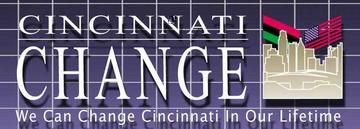TIF stands for tax increment financing.
 Tax Increment Financing (TIF) is a way for Cincinnati to intercept some of the taxes that would be paid by owners of real estate. TIF uses the additional property taxes paid as a result of development in the district to pay for part of the re-development costs that will make this city great.
Tax Increment Financing (TIF) is a way for Cincinnati to intercept some of the taxes that would be paid by owners of real estate. TIF uses the additional property taxes paid as a result of development in the district to pay for part of the re-development costs that will make this city great.When a Cincinnati Change Change Agent Developer renovates and or constructs a new building, the market value of the property and its property taxes typically rise. Classic examples would be building a new store on an undeveloped parcel or replacing one or more old buildings with a renovated and or new, larger building.
In both of these instances, the market value of the property will rise because the improvements add value to the parcel.
Tax increment financing (TIF) is a way for governments to help finance new capital projects by taking advantage of expected property tax returns.
When a TIF district is created, the county auditor certifies the current tax capacity of the properties in the district as the TIF district's "original tax capacity." As the property in the district increases in value, these increases above the original tax capacity are "captured." The law refers to this amount as the district's "captured tax capacity."
If we fiully impliment the Cincinnati Change plan of action then we expect to redirects payment of property taxes in the amount of the value of new improvements. TIF does not exempt public improvements from taxation. Rather, the taxes continue to be paid but are redirected to the City rather than the tradition disbursement among the City, County and Board of Education.
[Note: In most cases, 25% of the incremental revenues are dedicated to the Schools and should be factored into any calculations about the amount of revenue available for public infrastructure. We hope that this will increase the funds to the public schools to lower the deficiet they are experiencing for the next 20 years.]
Based upon the terms/conditions of a negotiated Redevelopment Agreement between the City and a Cincinnati Change Agent Developer, Cincinnati Change, as a partner in the development, would look to invest in the people who need it most through a coalition of non governmental agencies and for profit businsses who will look to change the lives of residents of some of the areas wih the worst crime, old public infrastructure and provide support for young people and seniors.
Past program examples include Taft Broadcasting Corp., Village at Stetson Square: Luxury Apartments, Queen City Square, Atrium 1, The McAlpin Development, Shillito Lofts, Amantea Nonwovens Company Creation , Bridge Worldwide Office Expansion, CBS Personnel Holdings Expansion, Cinergy Center Expansion and Renovation, Convergys Corporation Retention and Expansion, Formica Corporation Relocation, Lab One Relocation & Expansion, Sun Chemical Corporation Expansion and Westin Hotel.
Lets give a current real world example, how the Cincinnati Change TIF Plan would work in Over the Rhine (OTR).
OTR Housing Capacity (drawn from the 2002 OTR Plan)
We can start from the premise that we want to maintain at least 5,000 of the existing habitable units. Most in some need of renovation. The pool of available housing options can be increased through renovating vacant buildings and developing vacant lots for housing.
There are approximately 500 vacant residential buildings in the neighborhood. These buildings originally included a minimum of 1 to a maximum of 20 housing units.
These units were small and often composed of multiple small rooms. For today’s purposes, if we assume that each building could contain between one and four units, there would be capacity for an average of an additional 1,000 units created in existing vacant buildings.
The vacant land inventory identified approximately 700 vacant parcels in the neighborhood. If those vacant parcels provided for even 200 building sites with one to two units each, there is the capacity for another 300 units of new construction.
In addition we envision the conversion of large institutional and commercial buildings retail spaces with OTR based creative class and or third frontier small office home offices.
Based on the many assumptions provided above, it is reasonable to consider that OTR has the capacity for approximately 6,300 housing units. At an average household size of 2.2, these 6,300 units could house a population of over 13,830 people, which would be similar to the neighborhood’s population of 15,025 in 1970’s (or about 10% less).
OTR is today a neighborhood of renters with a current homeownership rate of less than 5%, which is considerably lower than the approximately
38% homeownership rate for the City of Cincinnati.
Under the Cincinnati Change TIF Plan home ownership would rise over the next decade to over 40% through buy ins from current residents anfd those who move into the neighborhood and support home ownership by capture of the TIF revenues that lket us develop low moderate income hosuing for families in the coummunity now.
Through the Cincinnati Change TIF program we expect to support the creation of over $600M in public investment in over 1,000 Over the Rhine Businesses - all of whom would be required to be OTR homeowners.
Procedures
The Internal Finance Review Committee is to review each project. It is expected that the requesting Department will have requested, documented, reviewed, and formulated a recommendation based on the City's Investment Information Guidelines.
Then city council decides.
LETS ROLL

